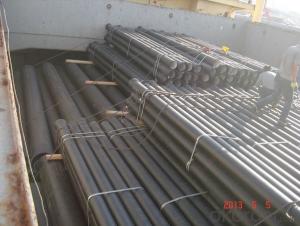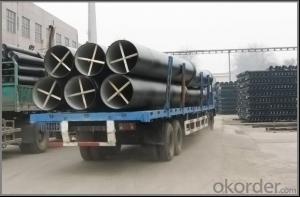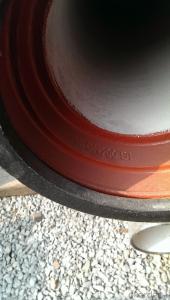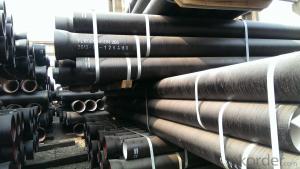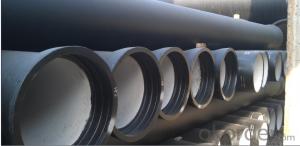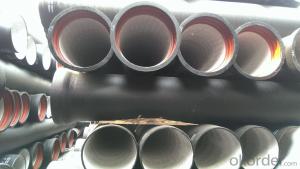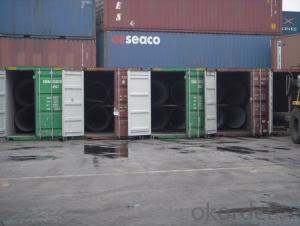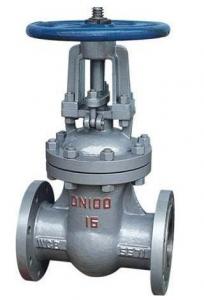DUCTILE IRON PIPE K9 DN 1000 SOCKET SPIGOT PIPES
- Loading Port:
- Tianjin
- Payment Terms:
- TT OR LC
- Min Order Qty:
- 25 m.t.
- Supply Capability:
- 30000 m.t./month
OKorder Service Pledge
OKorder Financial Service
You Might Also Like
1) The standard of pipe: ISO2531:1998, EN545:2006,K9 K8
2) Effective length: 6m/5.7m
3) Inner cement line: Portland cement lineas per ISO4179
4) Zinc coating: at least 130g/m2 as per ISO8179
5) Bitumen painting: at least 70μm as per ISO8179
6)With 102% quantity of NBR, SBR, or EPDM ring asper ISO4633
7) DN80-DN1200
8) Highstrength, lighter than grey iron, good corrosion resistance, no furring, smallflow resistance, easy fixing, long life tome about 100 yeas
9)Checked by automatic inspection equipment
10) Composition:
Chemical composition | |||
Chemical composition | Ductile Cast Iron Pipe (%) | Grey iron pipe (%) | Steel pipe (%) |
C | 3.5-4.0 | 3.2-3.8 | 0.1-0.2 |
Si | 1.9-2.6 | 1.4-2.2 | 0.15-0.4 |
Mn | 0.15-0.45 | 0.4-0.6 | 0.3-0.6 |
P | ≤0.06 | ≤0.3 | 0.02-0.03 |
S | ≤0.02 | ≤0.1 | 0.02-0.03 |
Mg | 0.03-0.06 |
|
|
11) Feature:
Mechanical properties | |||
| Ductile Cast Iron Pipe | Grey Iron Pipe | Steel Pipe |
Tensile Strength(Mpa) | ≥420 | 150-260 | ≥400 |
Yield Strength(Mpa) | ≥300 | No Confirmation | No Confirmation |
Bending Strength(Mpa) | ≥590 | 200-360 | ≥400 |
Elongation (%) | ≥10 | Neglected | ≥18 |
Brinell Hardness(HBS) | ≤230 | ≤230 | About 140 |
12) T type mechanical joint
13) Packing: in bulk or container
PACKING: 1) Pipesare bundled together with the steel belt.
2) Wooden pieces are put between the pipes.
- Q: What is the relationship between the installation direction of the ductile iron pipe and the direction of flow?
- The use of cast iron by adding more than 18 nodularizer, after centrifugal ductile cast iron machine high speed centrifugal cast pipe, called "ductile" (Ductile Cast Iron Pipes), referred to as ball pipe, ductile iron pipe and ductile iron pipe etc.. The utility model is mainly used for conveying water, and is an ideal choice for tap water pipes.
- Q: How are ductile iron pipes protected against external soil loads?
- Ductile iron pipes are protected against external soil loads through a combination of proper installation techniques and the use of protective coatings. The pipes are installed in a manner that allows for adequate support and backfilling, which helps distribute the external soil loads evenly. Additionally, these pipes are often coated with materials such as epoxy or polyethylene to provide a barrier between the pipe and the surrounding soil, preventing corrosion and damage from external forces. This protective coating ensures the longevity and durability of ductile iron pipes in underground applications.
- Q: Are ductile iron pipes resistant to microbiologically induced corrosion?
- Yes, ductile iron pipes are generally resistant to microbiologically induced corrosion (MIC). Ductile iron is a type of cast iron that has been treated with magnesium to give it increased strength and flexibility. This treatment creates a protective layer on the surface of the iron, making it less susceptible to corrosion caused by microorganisms. MIC occurs when certain types of bacteria, fungi, or other microorganisms interact with the metal surface of pipes and produce corrosive byproducts. However, ductile iron is generally resistant to MIC because the protective layer formed during the manufacturing process acts as a barrier, preventing microorganisms from directly contacting the metal surface. Additionally, ductile iron pipes are often lined with cement mortar or other protective coatings, which further enhance their resistance to corrosion. These linings provide an additional layer of protection against microorganisms, reducing the potential for MIC. Despite these inherent resistance properties, it is important to note that the resistance to MIC can vary depending on the specific conditions and environment in which the pipes are installed. Factors such as water quality, temperature, and the presence of certain microorganisms can influence the susceptibility of ductile iron pipes to MIC. Therefore, it is essential to consider these factors and take appropriate measures to prevent MIC, such as regular monitoring of water quality, proper maintenance, and the use of corrosion inhibitors or biocides when necessary.
- Q: Can ductile iron pipes be used in areas with high temperature variations?
- Yes, ductile iron pipes can be used in areas with high temperature variations. Ductile iron pipes have excellent thermal conductivity and can withstand a wide range of temperature fluctuations without losing their structural integrity. They have a high coefficient of linear expansion, which allows them to expand and contract with temperature changes without causing significant stress on the pipe. This makes ductile iron pipes suitable for use in areas where there are extreme temperature variations, such as hot summers and cold winters. Additionally, ductile iron pipes have a high resistance to thermal shock, meaning they can handle sudden temperature changes without cracking or breaking. Overall, ductile iron pipes are a reliable and durable choice for areas with high temperature variations.
- Q: What are the different methods for repairing ductile iron pipe?
- There are several methods for repairing ductile iron pipe, including mechanical repair, epoxy repair, and welding. Mechanical repair involves using clamps or couplings to seal leaks or cracks in the pipe. Epoxy repair involves applying an epoxy coating or sealant to the damaged area to prevent further corrosion or leaks. Welding is another method used for repairing ductile iron pipe, where the damaged section is cut out and replaced with a new piece that is welded into place.
- Q: How are ductile iron pipes different from PVC pipes?
- Ductile iron pipes and PVC pipes are utilized extensively in plumbing and water distribution systems, but they differ significantly in terms of their composition and properties. Ductile iron pipes are crafted from a particular form of cast iron that contains graphite nodules, which provide the material with ductility and flexibility. Consequently, these pipes can endure high pressures and heavy loads without succumbing to breakage or cracking. Ductile iron pipes are renowned for their robustness and longevity, making them particularly suitable for underground applications and areas with substantial traffic. Conversely, PVC pipes are constructed from a plastic known as polyvinyl chloride. These pipes possess rigidity and lack the same level of strength as ductile iron pipes. PVC pipes are commonly employed in low-pressure scenarios, such as residential plumbing systems, irrigation, and drainage systems. These pipes are lightweight, easy to install, and resistant to corrosion, rendering them a favored option for residential and non-industrial purposes. The cost disparity between ductile iron pipes and PVC pipes represents another distinction. Due to higher material and production expenses, ductile iron pipes tend to be pricier. Conversely, PVC pipes are relatively inexpensive to manufacture, making them a cost-effective choice for numerous plumbing projects. In summary, the primary disparities between ductile iron pipes and PVC pipes involve their composition, strength, flexibility, and cost. Ductile iron pipes, formed from cast iron, are celebrated for their strength and durability, while PVC pipes, formed from plastic, are lighter and more cost-effective. The selection between these two types of pipes depends on the specific demands of the plumbing project, including pressure, load-bearing capacity, and budgetary considerations.
- Q: What is the average diameter range of ductile iron pipes?
- The average diameter range of ductile iron pipes can vary depending on the specific application and industry standards. However, in general, ductile iron pipes are available in a wide range of diameters to meet various requirements. Commonly, the average diameter range for ductile iron pipes can start from as small as 4 inches (100 mm) and go up to 64 inches (1600 mm) or even larger. These sizes are often used for water distribution, sewer systems, and other infrastructure projects. It is important to note that the specific diameter range of ductile iron pipes can be influenced by factors such as local regulations, project specifications, and engineering considerations. Therefore, it is recommended to consult industry standards and relevant authorities to determine the appropriate diameter range for a specific application.
- Q: How much is the working pressure of ductile iron pipe used in water supply pipe and how is MPa determined?
- In general, building materials products are production standards, the production process and specifications are required, pipe work pressure is based on the use of coffins and other factors set standards, pipes with different purposes, the pressure level is different.
- Q: What is the content of silicon in silicon molybdenum ductile iron?
- High silicon molybdenum ductile cast iron is developed for end users successfully reduces the cost, and the castings have high strength, good oxidation resistance, and has good performance under thermal cycling condition. This kind of ductile iron silicon content of 4% molybdenum content 0.6%-0.8%, currently designated as many car manifold and turbocharger shell, and molybdenum content than the silicon alloy casting 1% more for special high temperature exhaust pipe, heat treatment. High silicon molybdenum alloy nodular cast iron castings used in the production of automotive turbocharger.
- Q: Are ductile iron pipes resistant to sulfuric acid corrosion?
- Yes, ductile iron pipes are generally resistant to sulfuric acid corrosion due to their corrosion-resistant coatings and high chemical resistance.
Send your message to us
DUCTILE IRON PIPE K9 DN 1000 SOCKET SPIGOT PIPES
- Loading Port:
- Tianjin
- Payment Terms:
- TT OR LC
- Min Order Qty:
- 25 m.t.
- Supply Capability:
- 30000 m.t./month
OKorder Service Pledge
OKorder Financial Service
Similar products
Hot products
Hot Searches
Related keywords





